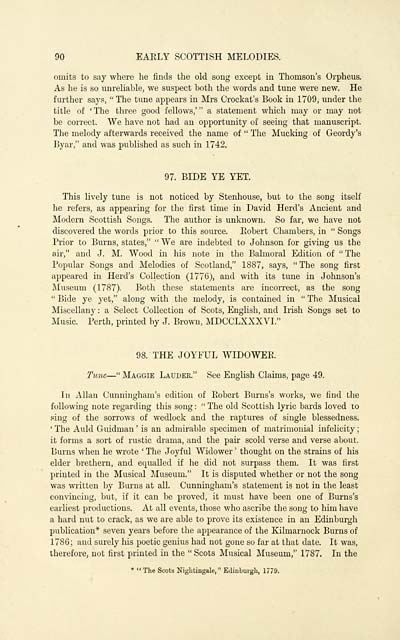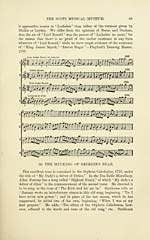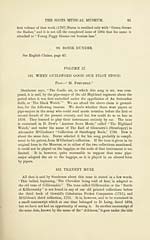Inglis Collection of printed music > Printed text > Early Scottish melodies
(112) Page 90 - Bide ye yet
Download files
Complete book:
Individual page:
Thumbnail gallery: Grid view | List view

90 EARLY SCOTTISH MELODIES.
omits to say where he finds the old song except in Thomson's Orpheus.
As he is so unreliable, we suspect both the words and tune were new. He
further says, " The tune appears in Mrs Crockat's Book in 1709, under the
title of ' The three good fellows,' " a statement which may or may not
be correct. We have not had an opportunity of seeing that manuscript.
The melody afterwards received the name of " The Mucking of Geordy's
Byar," and was published as such in 1742.
97. BIDE YE YET.
This lively tune is not noticed by Stenhouse, but to the song itself
he refers, as appearing for the first time in David Herd's Ancient and
Modern Scottish Songs. The author is unknown. So far, we have not
discovered the words prior to this source. Bobert Chambers, in " Songs
Prior to Burns, states," " We are indebted to Johnson for giving us the
air," and J. M. Wood in his note in the Balmoral Edition of " The
Popular Songs and Melodies of Scotland," 1887, says, " The song first
appeared in Herd's Collection (1776), and with its tune in Johnson's
Museum (1787). Both these statements are incorrect, as the song
" Bide ye yet," along with the melody, is contained in " The Musical
Miscellany : a Select Collection of Scots, English, and Irish Songs set to
Music. Perth, printed by J. Brown, MDCCLXXXVI."
98. THE JOYPUL WIDOWER
Tune — " Maggie Lauder." See English Claims, page 49.
In Allan Cunningham's edition of Robert Burns's works, we find the
following note regarding this song : " The old Scottish lyric bards loved to
sing of the sorrows of wedlock and the raptures of single blessedness.
' The Auld Guidman ' is an admirable specimen of matrimonial infelicity ;
it forms a sort of rustic drama, and the pair scold verse and verse about.
Burns when he wrote ' The Joyful Widower ' thought on the strains of his
elder brethern, and equalled if he did not surpass them. It was first
printed in the Musical Museum." It is disputed whether or not the song
was written by Burns at all. Cunningham's statement is not in the least
convincing, but, if it can be proved, it must have been one of Burns's
earliest productions. At all events, those who ascribe the song to him have
a hard nut to crack, as we are able to prove its existence in an Edinburgh
publication* seven years before the appearance of the Kilmarnock Burns of
1786; and surely his poetic genius had not gone so far at that date. It was,
therefore, not first printed in the " Scots Musical Museum," 1787. In the
* " The Scots Kightiiigale, " Edinburgh, 1779.
omits to say where he finds the old song except in Thomson's Orpheus.
As he is so unreliable, we suspect both the words and tune were new. He
further says, " The tune appears in Mrs Crockat's Book in 1709, under the
title of ' The three good fellows,' " a statement which may or may not
be correct. We have not had an opportunity of seeing that manuscript.
The melody afterwards received the name of " The Mucking of Geordy's
Byar," and was published as such in 1742.
97. BIDE YE YET.
This lively tune is not noticed by Stenhouse, but to the song itself
he refers, as appearing for the first time in David Herd's Ancient and
Modern Scottish Songs. The author is unknown. So far, we have not
discovered the words prior to this source. Bobert Chambers, in " Songs
Prior to Burns, states," " We are indebted to Johnson for giving us the
air," and J. M. Wood in his note in the Balmoral Edition of " The
Popular Songs and Melodies of Scotland," 1887, says, " The song first
appeared in Herd's Collection (1776), and with its tune in Johnson's
Museum (1787). Both these statements are incorrect, as the song
" Bide ye yet," along with the melody, is contained in " The Musical
Miscellany : a Select Collection of Scots, English, and Irish Songs set to
Music. Perth, printed by J. Brown, MDCCLXXXVI."
98. THE JOYPUL WIDOWER
Tune — " Maggie Lauder." See English Claims, page 49.
In Allan Cunningham's edition of Robert Burns's works, we find the
following note regarding this song : " The old Scottish lyric bards loved to
sing of the sorrows of wedlock and the raptures of single blessedness.
' The Auld Guidman ' is an admirable specimen of matrimonial infelicity ;
it forms a sort of rustic drama, and the pair scold verse and verse about.
Burns when he wrote ' The Joyful Widower ' thought on the strains of his
elder brethern, and equalled if he did not surpass them. It was first
printed in the Musical Museum." It is disputed whether or not the song
was written by Burns at all. Cunningham's statement is not in the least
convincing, but, if it can be proved, it must have been one of Burns's
earliest productions. At all events, those who ascribe the song to him have
a hard nut to crack, as we are able to prove its existence in an Edinburgh
publication* seven years before the appearance of the Kilmarnock Burns of
1786; and surely his poetic genius had not gone so far at that date. It was,
therefore, not first printed in the " Scots Musical Museum," 1787. In the
* " The Scots Kightiiigale, " Edinburgh, 1779.
Set display mode to: Large image | Transcription
Images and transcriptions on this page, including medium image downloads, may be used under the Creative Commons Attribution 4.0 International Licence unless otherwise stated. ![]()
| Special collections of printed music > Inglis Collection of printed music > Printed text > Early Scottish melodies > (112) Page 90 - Bide ye yet |
|---|
| Permanent URL | https://digital.nls.uk/94644616 |
|---|---|
| Description | Also: The joyful widower |
| Description | Scottish and English songs, military music and keyboard music of the 18th and 19th centuries. These items are from the collection of Alexander Wood Inglis of Glencorse (1854 to 1929). Also includes a few manuscripts, some treatises and other books on the subject. |
|---|
| Description | The Glen Collection and the Inglis Collection represent mainly 18th and 19th century Scottish music, including Scottish songs. The collections of Berlioz and Verdi collected by bibliographer Cecil Hopkinson contain contemporary and later editions of the works of the two composers Berlioz and Verdi. |
|---|

